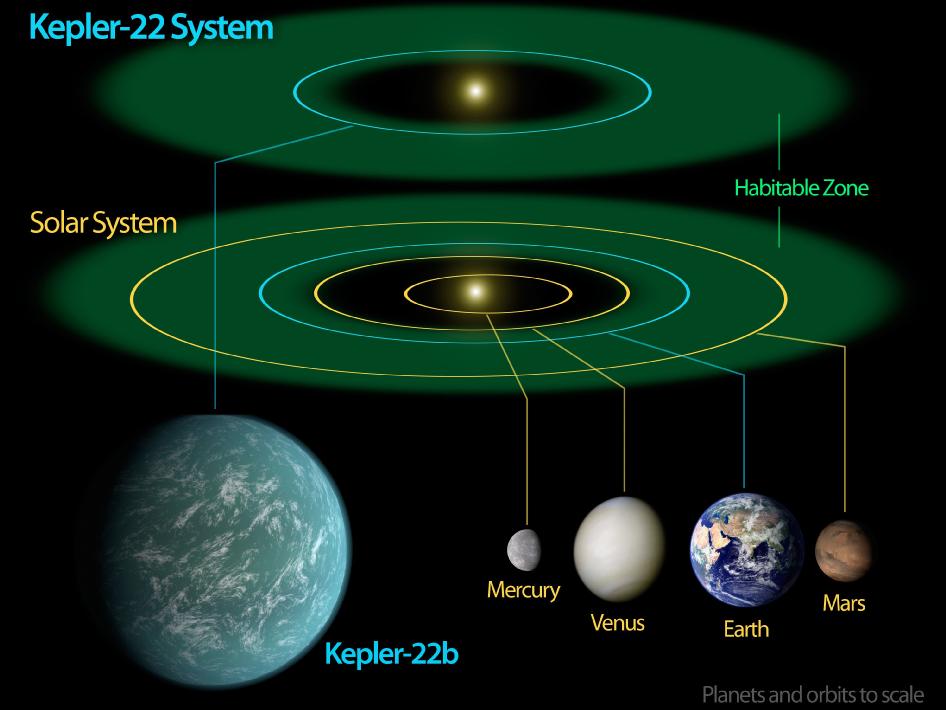Keppler system. NASA
Recently discovered planet Keppler 22b is orbiting its sun within the habitable zone as defined by astrobiologists. The surface temperature is comfortable 20° Celsius and there may thus be liquid water. Keppler system is some 600 light years from our Sun and is one of the more promising locations to look for signs of extraterrestrial life. In fact, a SETI project is already being developed to start listening for intelligent signals from that direction towards the constellation of Cygnus.
Communication problems
If there is life in the oceans of Keppler 22b how might those creatures look like?
There is no realistic hope that we would have space craft and robots visiting Keppler 22b in the near future. Space travel is a bit expensive.
Of course, we will be very happy if the intelligent folks over there start to send us images of their modern and ancient flora and fauna over some shared frequencies. But alas, the universal speed limit set by speed of light...
Even if a SETI project successfully establishes detects a cosmic radio station built by the inhabitants of Keppler 22b the good fellows will get and decode our earthly signals only in about 600 years from now that is in 2612. Of course, they will right away realize that the intelligent message came from that tiny planet X near that middle sized star and respond promptly in return mail. But even in that happy case we can expect their answers only in another 1200 years or about 3212 AD. Talking about long-term projects...
Options for extraterrestrial life forms
Anomalocaris. An artist's view
Credit Katrina Kenny/University of Adelaide, Australia
In order to find out some options let us take a 500 million years trip to another planet instead of distant Keppler 22b. That planet is also orbiting its sun in the habitable zone and has a surface temperature that makes presence of liquid water and thus life as we know it possible. The planet is located in the Milky Way Galaxy and scientists call it Tellus. A more common name is planet Earth.
We can get over 500 million year old signals of life from Tellus without using telescopes or turning the Hubble mirrors. Instead of detecting light signals that allow astronomers to analyse stellar spectra and through it the chemistry of the object we have actual specimens of other life forms available in what is commonly called fossil evidence.
Tellus has even today a most wonderful - although sadly dwindling - biodiversity. But when we examine the full known range of three billion years of history of life here we start to realize what a true paradise and what a rare planet our Earth really is in the local group of galaxies.
Cambrian explosion of life
When we travel those 500 million years back in time to young Earth - the explosion of life in Cambrian period we meet an extraordinary interesting and even fantastic world of God's creatures. One of the most fascinating pockets of survival of that era and protected for us by our good Lord is Burgess Shale in British Columbia, Canada.
Wonderful Life: The Burgess Shale and the Nature of History (1989) is a book on the evolution of Cambrian fauna by Harvard paleontologist Stephen Jay Gould. The volume was the 1991 winner of The Aventis Prizes for Science Books, and a 1991 finalist for the Pulitzer Prize..
(wikipedia)
(wikipedia)
Another pocket has survived in Kangaroo Island off the coast of Australia from where the fossilised exceptionally well preserved eyes of our example were recently discovered. The discovery is a truly staggering victory to the slow and patient work of Palaeontology. The remains show that the delicate composite eyes of the largest predator of the time Anomalocaris had over 16000 lenses letting it see underwater very sharply and almost in 360° degrees.
Not an alien
Anomalocaris is an anomality, as its name says, yes. But no - this particular fellow is not an alien or extinct form of life on Tellus. Even the not-so-highly educated but highly sympathetic friend of Forrest Gump, Bubba Blue, would immediately have recognized its shrimp like features.
Near and far relatives, cousins, nephews and grand-grand-....-children of the scary looking huge shrimp like anomalocaris share the planet today with us in the billions - biologists slump them all into a group called arthropods as they tend to have joint feet.
Dragonfly eyes.
For example, the amazing dragonflies composite eyes with many thousands of lenses are technically not so unlike from the eyes of anomalocaris.
Subject for another blog
Because the subject of early life on planet Earth is so fascinating and complicated I will open another blog for discussions on Cambrian life.



No comments:
Post a Comment